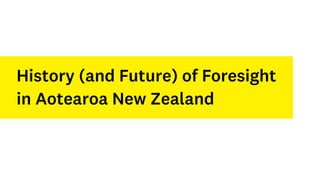20211029 5pm presented draft future of local govt review presentation
- 1. History (and Future) of Foresight in Aotearoa New Zealand
- 2. History, broadly conceived, is the interac(on of natural and man-made complexity. It would be very remarkable if this process resulted in predictable pa;erns. Even a rela=vely simple man-made edi?ce such as a bridge can fail from deteriora=on [etc]ˇ If it is hard for an engineer to foresee when a bridge may ˇ°go cri=calˇ±, then how much more di?cult is it to an=cipate the collapse of a large poli=cal structure?ˇŻ Niall Ferguson (2021, p. 79) 1.0 Why Scenarios?
- 3. Remarkably, Vesuvius did not produce the most destruc=ve erup=on of the Roman era: that was the Hatepe erup(on of Mount Taup§ŕ?, on New ZealandˇŻs North Island, in around 232. Major volcanic erup=onsˇ di?er from other forms of geographical disasters, earthquakes, in that they have global impacts on the earthˇŻs climateˇ [they inject millions of tons] of sulfate aerosol into the stratosphereˇ. However, volcanic erup=ons do more that kill those close to them. [All major erup=ons had signi?cant clima=c consequences and hence agricultural and nutri=onal consequencesˇ resul=ng in cold summers, drought, poor harvests and famineˇ severe winters, constant fog and respiratory problems.] Niall Ferguson (2021, pp. 83-85)
- 4. Foresight: The cone of plausibility 4
- 5. Foresight: Two types of analytical thinking 5
- 6. 6 Pandemic crisis Intermittent noise Biodiversity crisis Low-frequency noise Climate crisis Continuous noise Three crises A noisy world Three crises ¨C Three different types of noise
- 7. 2.0 The Past: A History of Future-thinking Initiatives in New Zealand, 1936¨C2010
- 8. 8 Four-step model for planning future-thinking initiatives
- 9. 9 Foresight in Aotearoa New Zealand since 1976
- 10. 1982 Commission for the Future ˇ®Future ContingenciesˇŻ 10
- 11. Revisiting Tomorrow: Navigating with Foresight event (30 Oct 2019) 11
- 12. 12 3.0. The Long-term Insights Briefings (the Briefings)
- 13. The Long-term Insights Briefings Australian Government Clean Energy Regulator 13
- 14. ˇ®It is a chance to look with fresh eyes at the kind of society we want to create in a world where knowledge is replacing the old sources of wealth and power as the driving force in the worldˇŻs most successful societies ˇ Most New Zealanders yearn for a nation which is confident, progressive, more prosperous, tolerant, and which cares for its people ˇ They seek a society capable of sustaining its First World status with well educated, innovative citizens who choose to stay in New Zealand because it is the best possible place to be.ˇŻ Prime Minister Helen Clark (2001) The Catching the Knowledge Wave
- 15. 14+ Local Councils prepared and published scenarios 15
- 16. National Civil Defence Emergency Management Plan Order 2015 16
- 17. Goal: To create a New Zealand Reference Scenarios framework 17
- 18. 1. Why does local government exist in 2050? 2. What does it do (and not do) in 2050? 3. How does it deliver what it does in 2050? 4. What legitimises its power 2050? 5. How does it support Te Triti in 2050? 6. How will it work with ministers and central government in 2050? 7. How is it funded in 2050? Key Questions:
- 20. 20
- 22. ˇ®Ultimately, extreme weather frequency and intensity may cause sustained operational disruption and network growth limitations, which may adversely impact Air New ZealandˇŻs cost base, future revenue, customer experience and reputation.ˇŻ Project: ClimateChangeNZ 22
- 23. Thank you.

![History, broadly conceived, is the interac(on of natural and
man-made complexity. It would be very remarkable if this
process resulted in predictable pa;erns.
Even a rela=vely simple man-made edi?ce such as a bridge
can fail from deteriora=on [etc]ˇ
If it is hard for an engineer to foresee when a bridge may
ˇ°go cri=calˇ±, then how much more di?cult is it to an=cipate
the collapse of a large poli=cal structure?ˇŻ
Niall Ferguson (2021, p. 79)
1.0 Why Scenarios?](https://image.slidesharecdn.com/202110295pmpresenteddraftfutureoflocalgovtreviewpresentation-211029035630/85/20211029-5pm-presented-draft-future-of-local-govt-review-presentation-2-320.jpg)
![Remarkably, Vesuvius did not produce the most destruc=ve
erup=on of the Roman era: that was the Hatepe erup(on of
Mount Taup§ŕ?, on New ZealandˇŻs North Island, in around 232.
Major volcanic erup=onsˇ di?er from other forms of
geographical disasters, earthquakes, in that they have global
impacts on the earthˇŻs climateˇ [they inject millions of tons] of
sulfate aerosol into the stratosphereˇ. However, volcanic
erup=ons do more that kill those close to them. [All major
erup=ons had signi?cant clima=c consequences and hence
agricultural and nutri=onal consequencesˇ resul=ng in cold
summers, drought, poor harvests and famineˇ severe winters,
constant fog and respiratory problems.]
Niall Ferguson (2021, pp. 83-85)](https://image.slidesharecdn.com/202110295pmpresenteddraftfutureoflocalgovtreviewpresentation-211029035630/85/20211029-5pm-presented-draft-future-of-local-govt-review-presentation-3-320.jpg)



















